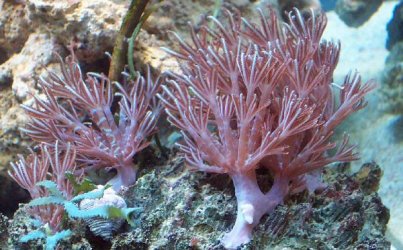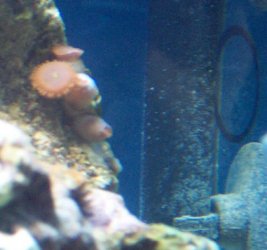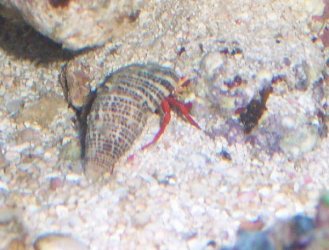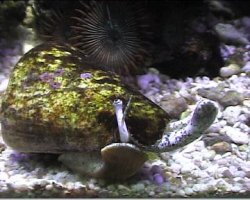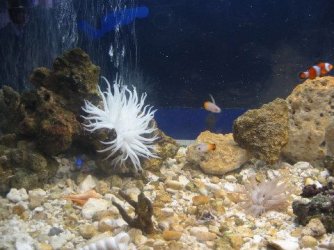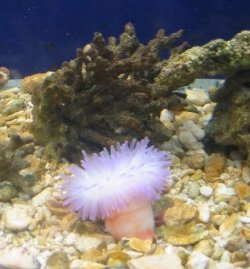You are using an out of date browser. It may not display this or other websites correctly.
You should upgrade or use an alternative browser.
You should upgrade or use an alternative browser.
Nano-Reef
- Thread starter EddieW
- Start date
🐠 May TOTM Voting is Live! 🐠
🏆 Click here to Vote! 🏆
EddieW
Fish Addict
The zoos that came with the live rock are gradually recovering from their transport ordeal - another one has now opened up....
Also getting a nice build up of coralline algae building up on the tank equipment in the background.
The tank has settled in well, ammonia and nitrites both back to zero and nitrate not too bad. Already got lots of 'pods swimming around so there is plenty of food for everything.
Also getting a nice build up of coralline algae building up on the tank equipment in the background.
The tank has settled in well, ammonia and nitrites both back to zero and nitrate not too bad. Already got lots of 'pods swimming around so there is plenty of food for everything.
Attachments
EddieW
Fish Addict
ginamoore
Fish Crazy
yes i guess it is a good idea to get rid of the anemones sense you have such lovely coral. Me one the other hand have a fish only tank with 3 anemones and of course my blue spotted puffer that are not reef safe  . I would love to get some coral for my 125gl but i dont have the heart to get rid of my puffer or anemone's. so i guess i am stuck with fish only unless you can think of some coral that would do good in my tank. here are some pictures of my anemones. i
. I would love to get some coral for my 125gl but i dont have the heart to get rid of my puffer or anemone's. so i guess i am stuck with fish only unless you can think of some coral that would do good in my tank. here are some pictures of my anemones. i  them lol
them lol
 . I would love to get some coral for my 125gl but i dont have the heart to get rid of my puffer or anemone's. so i guess i am stuck with fish only unless you can think of some coral that would do good in my tank. here are some pictures of my anemones. i
. I would love to get some coral for my 125gl but i dont have the heart to get rid of my puffer or anemone's. so i guess i am stuck with fish only unless you can think of some coral that would do good in my tank. here are some pictures of my anemones. i  them lol
them lolAttachments
ginamoore
Fish Crazy
EddieW
Fish Addict
Ta for the feedback.
Set2k3 - "sand cone shells", can't find that one on google. Any idea of another name? Possibly astrea? I am going to get some ceruth, astrea and nassarus snails shortly to help with the detrius.
Gina - defintely want to have at least one anenome in there but have to make sure it will be reef safe. Also need to wait until the tank is a bit more established otherwise it is likely to starve to death.
Cheers, Eddie
Set2k3 - "sand cone shells", can't find that one on google. Any idea of another name? Possibly astrea? I am going to get some ceruth, astrea and nassarus snails shortly to help with the detrius.
Gina - defintely want to have at least one anenome in there but have to make sure it will be reef safe. Also need to wait until the tank is a bit more established otherwise it is likely to starve to death.
Cheers, Eddie
ginamoore
Fish Crazy
i have had my anemone's for almost a year (except for the white one that is a new member to my tank.) I hand feed them evey other day to make sure they eat right. I was reading last week that you should only have one anemone per tank but mine seem to be doing good. i wish the lfs would have told me before i bought my white one! My tank should be mature enough i think, i had my 55gl for over a year and just transfured everything into a 125gl. and i transfered everything including my bacteria covered filters. and gravel and live rock not to mention i have got more live rock and getting more when possable. What do you think? and how can i tell if my anemones will be reef safe? they are planted and havent moved. they are happy were the are i guess. should i put coral as far away from them as possable? and hope they dont sting it?
EddieW
Fish Addict
Not an expert on this stuff by any means (yet  ).....
).....
It all sounds good to me - a year should have allowed plenty of time for all the necessary stuff to grow.
I am terrible at identifying anemones but the first looks like a condy anemone - here's the blurb from liveaquaria.com:
The second looks a bit like a bubble tip anemone. Here is some blurb from centralpets.com:
Not sure what, if any, polyps or corals would be suitable in your tank. Might be worth posting the pics in Anemones section of ReefCentral to get a positive ID on them. Once you know what they are you can ask on the forums what would go with them and get much better answers than I can give you.
HTH, Eddie
It all sounds good to me - a year should have allowed plenty of time for all the necessary stuff to grow.
I am terrible at identifying anemones but the first looks like a condy anemone - here's the blurb from liveaquaria.com:
The Condy Anemone is also known as the Haitian Anemone or Giant Golden Anemone. It is found throughout the Caribbean and Western Atlantic, in lagoons or on inner reefs, as individuals, or loose groups. It is never found in connected clusters. A disc diameter of about 4" (10 cm) is common in an aquarium. This species has diverse color variations. The base color is usually brown to white and the tentacles may or may not have magenta, purple, or green tips on its long tapering tentacles. The tentacles may occasionally develop a bubble-like appearance to them. It prefers to bury its base in the sand or into the crevice of a rock for protection.
The Condy Anemone requires strong light and should never be purchased if a good lighting system is not in place. It will do well in an aquarium with live rock and several crustaceans. Although a Condy requires a reef environment, it is not the best suited for the reef aquarium. The Condy Anemone moves around the tank and has a sting that can inflict grave damage to other anemones and corals. Do not include its natural predators such as the Red-Leg Hermit Crab. Unlike other anemones, the Condy Anemone does not have a relationship with any particular fish, and it is rare for any type of clownfish or damsel to reside within them.
The diet should include feedings of fish, mussels, shrimp, or other foods of this type.
The second looks a bit like a bubble tip anemone. Here is some blurb from centralpets.com:
The popular Bubble Tip Anemone is the favorite anemone of the Maroon Clown Fish. This anemone has an appearance unique among many captive anemones, and is considered by many to be easier to care for than many other anemones commonly used to host Clown Fish.
Bubble Tip Anemones often remain in the area of the aquarium they are placed in, and do not often wander about their tanks. In the cases that they do move around, it is usually due to conditions that they are unhappy with. Generally, they prefer to be in an area of moderate current, though not in a strong direct current. Many aquarists claim that a random or alternating current works best for Bubble Tip Anemones. Bright lighting is also important for Bubble Tip Anemones since they are photosynthetic, as is good water quality. In the wild, Bubble Tip Anemones are found in two locations. Large specimens, with tentacles that are more streaming or stringy, are often found in deeper waters with more dimly lit conditions. These specimens are often solitary. Smaller specimens are often located in groups or colonies, nearer to the surface, in bright sunlight. These specimens tend to show the bulbous tips on their tentacles that are characteristic to Bubble Tip Anemones. Although there are various theories about why some Bubble Tip Anemones develop these tips and some do not, it is widely believed that the bulbs are related to the light level in the anemone's habitat; specimens given more light are believed to have bubble tipped tentacles.
Bubble Tip Anemones come in a variety of colors. Some are red, orange, or pink, while others are green or brown. By far the most common colors found in the pet trade are brownish and green. Often, specimens found in deeper waters are green or brown. The red and pink specimens are the most sought after and are often known as Rose Anemones. Small specimens should be purchased, since they tend to adapt better to captivity than large specimens. Mature Bubble Tip Anemones often grow to diameters of 12 inches (30 centimeters). Wild specimens found in deeper waters may be 20 inches (50 centimeters) in diameter. As the name implies, the tips of a Bubble Tip Anemone's tentacles are often slightly swelled or bulbous.
These anemones are found in the Indo-Pacific, Indian Ocean, and Red Sea.
Not sure what, if any, polyps or corals would be suitable in your tank. Might be worth posting the pics in Anemones section of ReefCentral to get a positive ID on them. Once you know what they are you can ask on the forums what would go with them and get much better answers than I can give you.
HTH, Eddie
Latest Discussions
- Replies
- 3
- Views
- 76
- Replies
- 2
- Views
- 48
- Replies
- 12
- Views
- 132

